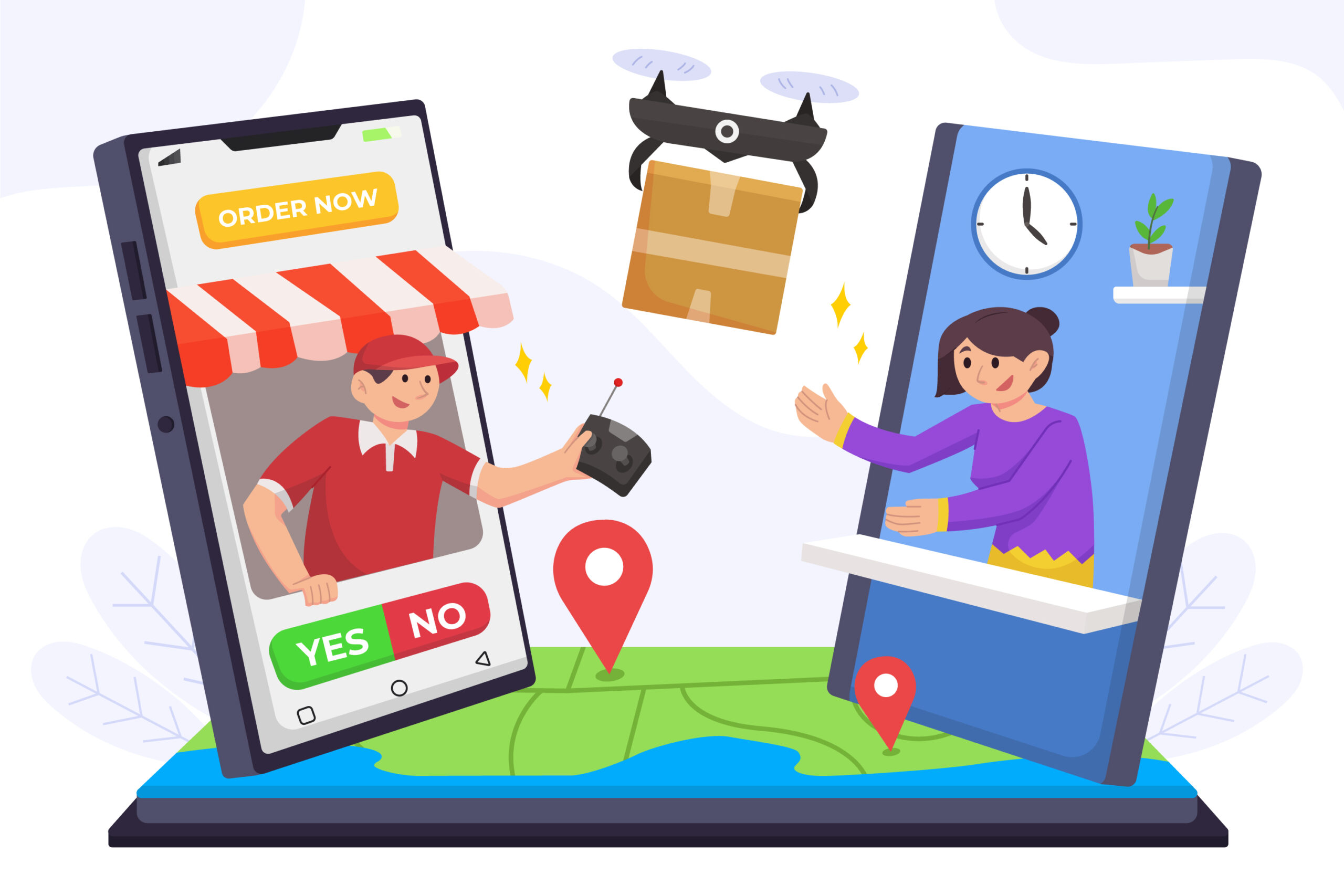Are you considering diving into the online business landscape but unsure whether dropshipping or traditional e-commerce is the right path for you? It’s a common dilemma among budding entrepreneurs, and rightly so. Both dropshipping and e-commerce offer unique advantages and challenges, making this a crucial decision for your business’s success.
Let’s break down the similarities and differences between dropshipping and e-commerce to help you make an informed choice:
What is Dropshipping?
Dropshipping is a retail fulfillment method where a store doesn’t keep the products it sells in its own inventory. Instead, when a store sells a product, it purchases the item from a third party and has it shipped to the customer. The seller doesn’t handle the product directly, eliminating the need for inventory storage and management.
What is E-commerce?
E-commerce, on the other hand, refers to any commercial transaction conducted online. It encompasses comprehensive activities, including selling physical or digital products, services, subscriptions, etc. In traditional e-commerce models, businesses typically buy products in bulk, store them in a warehouse, and handle shipping and fulfillment themselves.
The Similarities Between E-commerce and Dropshipping

Online Presence
Both e-commerce and dropshipping operate primarily in the digital realm. They leverage websites and online platforms to reach customers, showcase products, and facilitate transactions.
Focus on Customer Experience
Whether running an e-commerce store or a dropshipping business, providing an excellent customer experience is paramount. This includes fast shipping, responsive customer service, and user-friendly websites.
Marketing Strategies
E-commerce and dropshipping businesses often employ similar marketing tactics to attract customers. This may include social media marketing, email campaigns, search engine optimization (SEO), and content marketing.
Revenue Generation
At their core, e-commerce and dropshipping are revenue-generating endeavors. They aim to sell products or services to customers and generate profits for the business owner.
While e-commerce and dropshipping may have nuances, they share fundamental similarities that make them both viable options for aspiring online entrepreneurs.
Pros and Cons of Dropshipping
Pros
- Low Startup Costs: Since you don’t need to invest in inventory upfront, the barrier to entry for dropshipping is relatively low.
- Flexibility: Dropshipping allows you to experiment with different products and niches without being stuck with unsold inventory.
- Scalability: With drop shipping, scaling your business is more manageable since you don’t have to worry about inventory management or warehousing logistics.
Cons
- Lower Profit Margins: Since you’re not purchasing products in bulk, the profit margins in dropshipping are typically lower compared to traditional e-commerce.
- Dependency on Suppliers: Your business’s success in dropshipping is heavily reliant on the reliability and efficiency of your suppliers.
- Quality Control: As you’re not handling the products yourself, maintaining quality control can be challenging, potentially leading to customer dissatisfaction.
Pros and Cons of E-commerce

Pros
- Higher Profit Margins: Buying products in bulk often allows for better pricing, resulting in higher profit margins for ecommerce businesses.
- Control Over Inventory: With ecommerce, you have full control over your inventory, allowing you to ensure product quality and manage stock levels efficiently.
- Brand Building: Owning and managing your inventory gives you more opportunities to build a strong brand identity and customer loyalty.
Cons
- Higher Initial Investment: E-commerce typically requires a higher initial investment to purchase inventory and set up warehousing and fulfillment operations.
- Inventory Management: Managing inventory can be complex and time-consuming, requiring careful planning and logistics.
- Risk of Unsold Inventory: Unlike dropshipping, where you only purchase products as they’re sold, e-commerce businesses risk being stuck with unsold inventory if products don’t sell as expected.
Understanding E-commerce Business Budgets
E-commerce businesses come in various shapes and sizes, from small independent stores to large-scale enterprises. Your budget will largely depend on the scale and ambition of your venture. Here are some key components to consider when budgeting for an e-commerce business:
1. Website Development and Maintenance
Your online store is the cornerstone of your e-commerce business. Budget for website development, including design, coding, and hosting fees. Additionally, factor in ongoing maintenance costs to keep your website running smoothly.
2. Inventory Procurement
If you plan to sell physical products, allocate a significant portion of your budget to inventory procurement. This includes purchasing products, warehousing fees (if applicable), and logistics costs.
3. Marketing and Advertising
Building brand awareness and driving traffic to your e-commerce store requires a robust marketing strategy. Budget for various marketing channels such as social media advertising, search engine optimization (SEO), email marketing, and influencer partnerships.
4. Payment Processing Fees
Every transaction built through your e-commerce store incurs payment processing fees. Research different payment gateways and their associated fees to budget accordingly.
5. Customer Service
Providing exceptional customer service is crucial for retaining purchasers and building a loyal customer base. Budget for customer service tools, staff training, and personnel costs if planning to hire customer service representatives.
6. Technology and Software
Invest in e-commerce platforms, analytics tools, and other software solutions to streamline your operations and enhance the customer experience.
Deciphering Dropshipping Business Budgets
Dropshipping offers a low barrier to entry for aspiring entrepreneurs as it eliminates the need for inventory management and upfront product investment. However, that doesn’t mean dropshipping is entirely cost-free. Here’s what you need to consider when budgeting for a dropshipping business:
1. E-commerce Platform Fees
While you may not need to invest in inventory upfront, you’ll still need to pay for an e-commerce platform to host your dropshipping store. Research platforms that support dropshipping integrations and compare their pricing plans.
2. Marketing and Advertising
Just like traditional e-commerce businesses, dropshipping ventures require marketing and advertising efforts to attract customers. Allocate a portion of your budget to promote your dropshipping store through various channels.
3. Customer Service
While you may not handle product fulfillment, you’re still responsible for providing customer support. Budget for customer service tools and resources to address inquiries, concerns, and handle returns efficiently.
4. Quality Control
Since relying on third-party suppliers to fulfill orders, invest in quality control measures to ensure products meet your customers’ expectations. This may involve ordering samples, conducting product tests, or vetting suppliers rigorously.
What Budget Do You Need?

The million-dollar question remains: What budget do you need to start an e-commerce or dropshipping business? The answer varies significantly based on your business model, niche, and growth aspirations. However, here are some general guidelines to consider:
Start Small
You don’t need a massive budget to get started. Many successful e-commerce and dropshipping entrepreneurs began with modest budgets and gradually reinvested profits to scale their businesses.
Focus on Essentials
Set realistic expectations and avoid overspending on unnecessary expenses, especially in the early stages of your business. Monitor your finances closely and adjust your budget based on performance and market conditions.
Note : Success in the e-commerce landscape is not solely determined by the size of your budget but by your creativity, perseverance, and ability to adapt to changing market dynamics.
Choosing the Best Option for Your Business
So, which option is right for you? It ultimately depends on your specific circumstances and goals. If you’re starting and want to minimize risk and upfront costs, dropshipping might be the way to go. On the other hand, if you have the capital to invest and prefer more control over your operations, traditional e-commerce could be a better fit.
Consider elements like your financial resources, the degree of authority you desire over your products, and your strategy for long-term expansion. Whichever option you choose, remember that e-commerce success requires dedication, hard work, and a solid understanding of your target market.
Whether you opt for dropshipping or traditional e-commerce, one thing is certain: you need a reliable platform to build and manage your online store. With wpXPRESS, you can create a professional, user-friendly website that showcases your products and provides a seamless shopping experience for your customers.
Contact us today to schedule a consultation and take the first step towards turning your ecommerce dreams into reality.





0 Comments